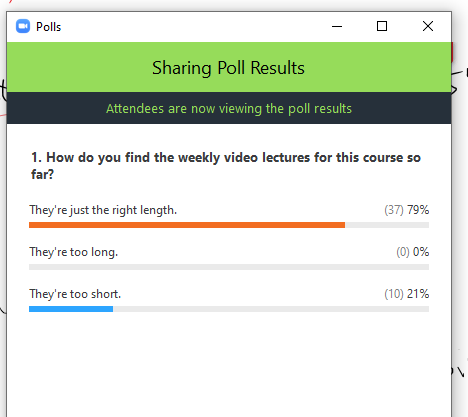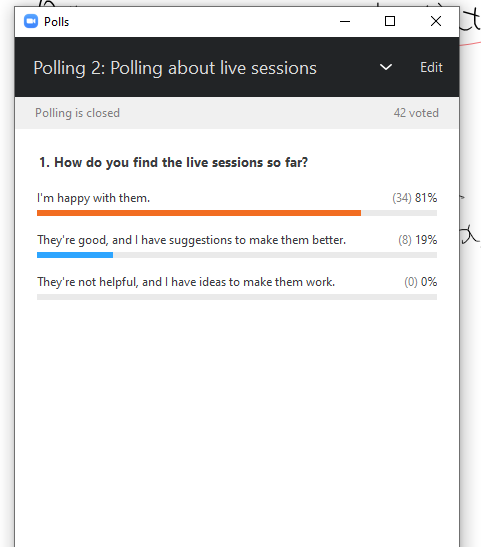Reading Week is finally here. I can take a deep breath and slow down a bit.
I’d like to take this opportunity to reflect on and share what works from my 2020 fall semester teaching, and what improvements are needed. My focus has shifted to building a learning community since the pandemic started in 2020 March. I believe being able to connect with students and offering them the space and opportunity to work with each other is more important than content covered for a course. At this point I think almost all of us have realized it’s not realistic to cover as much as what we used to do. The challenges that come with online teaching are not trivial to overcome, and I’d like to invite everyone to ponder on the question of what matters the most to you when it comes to student’s learning experience. For me it’s community: an inclusive community where I can reach everyone and offer multiple ways for students to engage with each other and with the course content.
About a week before 2020 fall semester started, I posted a welcome message to my class and shared the course syllabus, textbook information and how to join the online discussion forum and the social annotation tool hypothes.is. The message included a short survey form which helps me understand my students’ learning needs. Granted it’s a lot of information for students to take on. To make it more inclusive, I also made an interactive H5P presentation.
This presentation covers all the information in the course syllabus, with a few short built-in videos: my self-introduction, video of how to annotate on the open textbook we use, and an overview of Piazza, the discussion forum that we will be using. Hyperlinks in this presentation will lead them to the sign-up pages so once they go over all the slides, they are ready to start the semester. I also posted a thread of “introducing yourself” on Piazza. I started the thread by introducing myself, and ended my post by asking a question so the next person who responds will start by answering that question. Everyone follows this format and within a few days, a majority of the class have introduced themselves. It is the very first post students post which gives them the opportunity to get used to posting, and to get to know each other.
Once semester started, students slowly took control of the discussion forum and hypothes.is: they are answering each other’s questions in a timely manner so all I need to do is to clarify some common misunderstandings. Part of my course assessment structure is called “community building action (CBA)”: whenever students contribute to the community’s learning, they earn a CBA point. The contribution mostly comes in the form of posts, questions and answers on the discussion forum and Hypothes.is. They earn CBA points while helping each other learn. By the end of the semester, all 120 students enrolled in Piazza and there are 827 total posts, 3482 total contributions, 229 instructor’s responses, 724 students’ responses and response time is 11 min in average. There are also many fantastic discussions happening on Hypothes.is. Making these platforms available for students not only help them learn, it also helps them gain a sense of belonging. Students can post anonymously so they don’ t need to feel embarrassed if they are asking a trivial question. The number of emails I received from this course is minimal thanks to the discussion forum which is a happy side-effect that I’m keen to keep.
Another element I introduced to my course is oral exam. We have 3 scheduled term tests, and if a student is not feeling well on the test day, or missed a test due to any personal reasons which they do not need to disclose to me, they can opt for an oral test instead. This option is also offered to those who took the test but felt they did not do as well as they expected. In total I ran 35 oral tests, for a class of 120 students. Having this option in place reduced students’ anxiety of test taking and makes the course more inclusive.
The last piece I want to mention is offering a variety of assessments in the course. For multivariable calculus, we have CBA, weekly check point (a set of MCQ/TF questions that students complete before each week’s synchronous lessons), assignments and tests. In the end-of-semester survey I conducted, students expressed the gratitude of having a variety of assessments in this course. In my other course, MATH 2030 Combinatorics, we have weekly quizzes and presentation. A student could make a short video of any topic that was covered in our course and post it on the discussion forum to earn some bonus points. 20 out of 46 students submitted videos and the whole class benefited from watching and learning from them.
To summarize, in order to build an inclusive learning community, start early to reach out to students, and be present, both during and after synchronous sessions, listen to students and offer multiple ways for them to demonstrate their learning.

